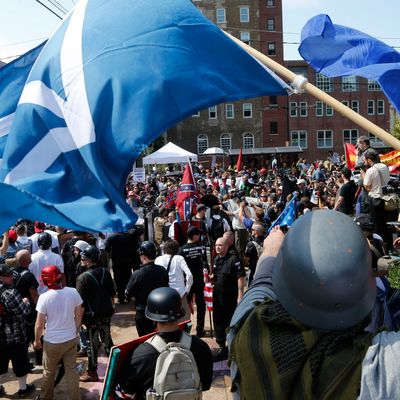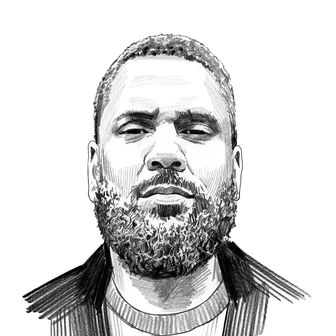
The historical ties between American law-enforcement agencies and white supremacist groups are well documented. Southern sheriffs abetted Ku Klux Klansmen under Jim Crow. The FBI posted a bulletin in 2006 warning about white nationalists and skinheads infiltrating police entities, citing cases in Ohio, Illinois, Texas, and California, including the formation of a neo-Nazi gang by officials within the Los Angeles County Sheriff’s Department. The armed forces have been implicated as well. Federal agents in February arrested a 49-year-old Coast Guard lieutenant and self-described white nationalist who had amassed 15 firearms and more than 1,000 rounds of ammunition while planning a massacre of innocent civilians “on a scale rarely seen in this country,” according to court documents.
Most of the accused are united as much by their bigoted beliefs as their ability to fortify them in private while maintaining a veneer of public respectability. But as has been true throughout history, the most recent reported case proves these impulses are not at odds. On the contrary, they are intimately connected, and often make one another possible.
The Daily Beast’s Kelly Weill reported this week that Daniel Morley, a 31-year-old school resource officer employed by L.C. Bird High School in Chesterfield, Virginia, is also an organizer for Identity Evropa, a white nationalist group also known as the American Identity Movement. His involvement was first exposed on Monday by Virginia anti-fascists, according to the report, who leaked the group’s online chat messages. (Morley has since been suspended, pending a departmental investigation). The exchanges they uncovered suggest that Morley holds an esteemed and valuable position within the organization: coordinating new recruits. His particular focus is on helping members hide their bigotry and racist aims from the public by employing misleading language.
According to Weill, this role is an extension of Morley’s activities going back a decade, to his days as a commenter on the white supremacist website Stormfront. “A good strategy would be to steer the definition of ‘racism’ towards ‘racial hatred,’” he reportedly counseled one Identity Evropa member last year. “We don’t hate other races, so we’re not racists. After all, the word isn’t going away. May as well control it.”
In order to be successful, this brand of subterfuge requires a public that is either too ignorant or in willful denial of racism’s machinations to look past the surface. Fortunately for Morley, he lives in the United States, where questions of racism are often litigated in terms of “what’s in a person’s heart,” or what they are willing to admit publicly. Such myopia permitted Representative Steve King of Iowa to espouse white nationalism for more than a decade, with the only rebuke from his fellow Republicans coming in January when he inquired (on the record, in a New York Times profile), “White nationalist, white supremacist, Western civilization — how did that language become offensive?” It is how U.S. senator and presidential candidate Cory Booker can respond to the question, “Do you believe that Donald Trump is a racist?” with, “I don’t know the heart of anybody. I’ll leave that to the Lord.”
Absent divine insight or X-ray vision, the rest of us will have to do better on our own. To this end, historical evidence is valuable: The impulse to obscure or deny one’s bigoted intentions is not new, nor is it limited to avowed white supremacists. It was being deployed in national politics decades before Donald Trump tried his hand at campaigning, as illuminated when Richard Nixon’s campaign consultant, Lee Atwater, explained the strategy behind his candidate’s efforts to woo southern whites away from the Democratic Party: “By 1968 you can’t say ‘nigger’ — that hurts you, backfires. So you say stuff like, uh, forced busing, states’ rights, and all that stuff, and you’re getting so abstract.”
Indeed, such behavior has become more useful in the post–civil-rights era, as open bigotry has become more taboo in polite company and the explicit racism of Jim Crow–era laws and sumptuary codes ran afoul of federal law, requiring evasive action among its adherents. This is where cries of “reverse racism” enter the discourse, where claims like Supreme Court Chief Justice John Roberts’s 2007 insistence that “the way to stop discrimination on the basis of race is to stop discriminating on the basis of race” captures the ethos of pols seeking to override civil-rights gains through fealty to a theoretical — but not actual — equality.
Other manifestations have been less mannered. Morley can find perhaps his most famous modern analogue in former KKK grand wizard David Duke, who has spent decades preoccupied with taking his brand of white nationalism mainstream. He has been remarkably successful. Duke, in 1989, was elected to a seat in Louisiana’s House of Representatives, where he served until 1992. These days, he can be found defending other bigots in public using canards and false equivalences. “[In] this country, if you simply defend the heritage of European-American people, then you’re automatically a racist,” he told NPR’s Morning Edition in 2016, defending Trump against charges of racism. “There’s massive racist — racial discrimination against European-Americans. And that’s the reality.”
These examples point to a shared, and perhaps obvious, conclusion: It is an easy and frequently successful pursuit to obscure racism by dressing it up in nice clothes. This can be accomplished literally or metaphorically. “Dapper” white nationalist Richard Spencer utilized the former en route to written profiles seemingly enthralled by his choice to wear a three-piece suit rather than a white hood. The latter is more Morley’s wheelhouse — moving goalposts and redefining terms, such that racism becomes harder to recognize and easier to hang on others while downplaying one’s own. That this could be accomplished so easily by an American police officer working alongside children — a man whose literal side job is to help bigots convince other people that they are not — should put to rest once and for all the notion that we must see into a person’s heart to know if they are a bigot. Obfuscation, clearly, is an important part of their game. At this point, continuing to be fooled is a choice.






























